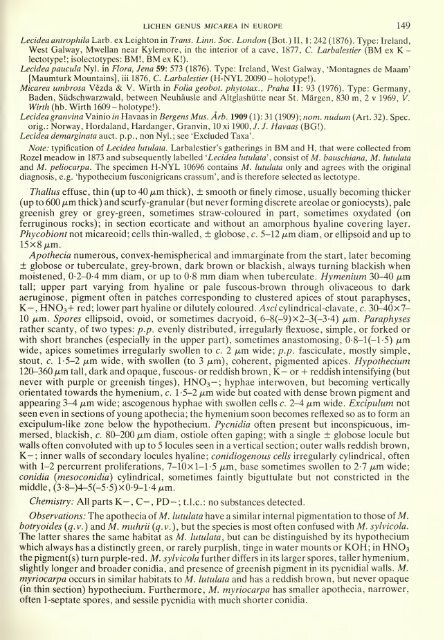Bulletin of the British Museum (Natural History)
Bulletin of the British Museum (Natural History)
Bulletin of the British Museum (Natural History)
Create successful ePaper yourself
Turn your PDF publications into a flip-book with our unique Google optimized e-Paper software.
LICHEN GENUS MICAREA IN EUROPE 149<br />
Lecidea antrophila Larb. ex Leighton in Trans. Linn. Soc. London (Bot.) II, 1: 242 (1876). Type: Ireland,<br />
West Galway, Mwellan near Kylemore, in <strong>the</strong> interior <strong>of</strong> a cave, 1877, C. Larbalestier (BM ex K -<br />
lectotype!; isolectotypes: BM!, BM ex K!).<br />
Lecidea paucula Nyl. in Flora, Jena 59: 573 (1876). Type: Ireland, West Galway, 'Montagnes de Maam'<br />
[Maumturk Mountains], iii 1876, C. Lflr/?fl/e5ner(H-NYL 20090 -holotype!).<br />
Micarea umbrosa Vezda & V. Wirth in Folia geobot. phytotax., Praha 11: 93 (1976). Type: Germany,<br />
Baden, Siidschwarzwald, between Neuhausle and Altglashiitte near St. Margen, 830 m, 2 v 1969, V.<br />
Wirth (hb. Wirth 1609 - holotype!).<br />
Lecidea granvina Vainio in Havaas in Bergens Mus. Arb. 1909 (1): 31 (1909); nom. nudum (Art. 32). Spec.<br />
orig.: Norway, Hordaland, Hardanger, Granvin, 10 xi 1900,7. J. Havaas (BG!).<br />
Lecidea demarginata auct. p.p., non Nyl.; see 'Excluded Taxa'.<br />
Note: typification <strong>of</strong> Lecidea lutulata. Larbalestier's ga<strong>the</strong>rings in BM and H, that were collected from<br />
Rozel meadow in 1873 and subsequently labelled 'Lecidea lutulata', consist <strong>of</strong> M. bauschiana, M. lutulata<br />
and M. peliocarpa. The specimen H-NYL 10696 contains M. lutulata only and agrees with <strong>the</strong> original<br />
diagnosis, e.g. 'hypo<strong>the</strong>cium fusconigricans crassum', and is <strong>the</strong>refore selected as lectotype.<br />
Thallus effuse, thin (up to 40 /xm thick), ± smooth or finely rimose, usually becoming thicker<br />
(up to 600 jxm thick) and scurfy-granular (but never forming discrete areolae or goniocysts) pale<br />
,<br />
greenish grey or grey-green, sometimes straw-coloured in part, sometimes oxydated (on<br />
ferruginous rocks); in section ecorticate and without an amorphous hyaline covering layer.<br />
Phycobiont not micareoid; cells thin-walled, ± globose, c. 5-12 /xm diam, or ellipsoid and up to<br />
15x8/xm.<br />
Apo<strong>the</strong>cia numerous, convex-hemispherical and immarginate from <strong>the</strong> start, later becoming<br />
± globose or tuberculate, grey-brown, dark brown or blackish, always turning blackish when<br />
moistened, 0-2-0-4 mm diam, or up to 0-8 mm diam when tuberculate. Hymenium 30-40 ^im<br />
tall; upper part varying from hyaline or pale fuscous-brown through olivaceous to dark<br />
aeruginose, pigment <strong>of</strong>ten in patches corresponding to clustered apices <strong>of</strong> stout paraphyses,<br />
K- , HNO3+ red; lower part hyaline or dilutely coloured. Asci cylindrical-clavate, c. 30-40x7-<br />
10 /am. Spores ellipsoid, ovoid, or sometimes dacryoid, 6-8 (-9) x 2-3 (-3 -4) yam. Paraphyses<br />
ra<strong>the</strong>r scanty, <strong>of</strong> two types: p.p. evenly distributed, irregularly flexuose, simple, or forked or<br />
with short branches (especially in <strong>the</strong> upper part), sometimes anastomosing, 0-8-l(-l-5) ^tm<br />
wide, apices sometimes irregularly swollen to c. 2 ^tm wide; p.p. fasciculate, mostly simple,<br />
stout, c. 1-5-2 /xm wide, with swollen (to 3 /xm), coherent, pigmented apices. Hypo<strong>the</strong>cium<br />
120-360 /x,m tall, dark and opaque, fuscous- or reddish brown, K- or -I- reddish intensifying (but<br />
never with purple or greenish tinges), HNO3-; hyphae interwoven, but becoming vertically<br />
orientated towards <strong>the</strong> hymenium, c. 1-5-2 /xm wide but coated with dense brown pigment and<br />
appearing 3-4 /xm wide; ascogenous hyphae with swollen cells c. 2-4 /xm wide. Excipulum not<br />
seen even in sections <strong>of</strong> young apo<strong>the</strong>cia; <strong>the</strong> hymenium soon becomes reflexed so as to form an<br />
excipulum-like zone below <strong>the</strong> hypo<strong>the</strong>cium. Pycnidia <strong>of</strong>ten present but inconspicuous, immersed,<br />
blackish, c. 80-200 /xm diam, ostiole <strong>of</strong>ten gaping; with a single ± globose locule but<br />
walls <strong>of</strong>ten convoluted with up to 5 locules seen in a vertical section; outer walls reddish brown,<br />
K-; inner walls <strong>of</strong> secondary locules hyaline; conidiogenous cells irregularly cylindrical, <strong>of</strong>ten<br />
with 1-2 percurrent proliferations, 7-10x1-1-5 /xm, base sometimes swollen to 2-7 /xm wide;<br />
conidia (mesoconidia) cylindrical, sometimes faintly biguttulate but not constricted in <strong>the</strong><br />
middle, (3-8-)4-5(-5-5)x0-9-l-4/xm.<br />
Chemistry: All parts K-, C-, PD-; t.l.c: no substances detected.<br />
Observations: The apo<strong>the</strong>cia <strong>of</strong> M. lutulata have a similar internal pigmentation to those <strong>of</strong> M.<br />
botryoides {q. v. ) and M. muhrii {q. v. ), but <strong>the</strong> species is most <strong>of</strong>ten confused with M. sylvicola.<br />
The latter shares <strong>the</strong> same habitat as M. lutulata, but can be distinguished by its hypo<strong>the</strong>cium<br />
which always has a distinctly green, or rarely purplish, tinge in water mounts or KOH; in HNO3<br />
<strong>the</strong> pigment(s) turn purple-red. M. sylvicola fur<strong>the</strong>r differs in its larger spores, taller hymenium,<br />
slightly longer and broader conidia, and presence <strong>of</strong> greenish pigment in its pycnidial walls. M.<br />
myriocarpa occurs in similar habitats to M. lutulata and has a reddish brown, but never opaque<br />
(in thin section) hypo<strong>the</strong>cium. Fur<strong>the</strong>rmore, M. myriocarpa has smaller apo<strong>the</strong>cia, narrower,<br />
<strong>of</strong>ten 1-septate spores, and sessile pycnidia with much shorter conidia.

















